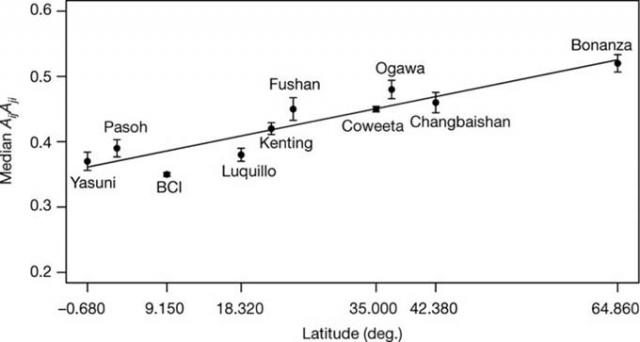Home > Research > Research Results > Research Results 2018 > Seasonality and in-situ interspecific competition among tree species were critical
Update:February 8, 2018
Main content starts here.
Seasonality and in-situ interspecific competition among tree species were critical
- presenting a new theory to explain changes in species diversity with latitude
| Article title |
Temporal coexistence mechanisms contribute to the latitudinal gradient in forest diversity |
|---|---|
| Author (affiliation) |
Jacob Usinowicz(a), Chia-Hao Chang-Yang(a,b), Yu-Yun Chen(b), James S. Clark(c), Christine Fletcher(d), Nancy C. Garwood(e), Zhanqing Hao(f), Jill Johnstone(g), Yiching Lin(h), Margaret R. Metz(i), Takashi Masaki(j), Tohru Nakashizuka(k), I-Fang Sun(l), Renato Valencia(m), Yunyun Wang(f), Jess K. Zimmerman(n), Anthony R. Ives(o), S. Joseph Wright(p) (a) Environmental Systems Science, ETH Zurich, Zurich, Switzerland. (b) National Dong Hwa University,Taiwan. (c) Duke University, Durham, NC, USA. (d) Forest Research Institute Malaysia, Kuala Lumpur, Malaysia. (e) Southern Illinois University, Carbondale, IL, USA. (f) Institute of Applied Ecology, Chinese Academy of Sciences, Shenyang, P.R.China. (g) University of Saskatchewan, Saskatoon, SK, Canada. (h) Tunghai University, Taichung, Taiwan. (i) Lewis & Clark College, Portland, OR, USA. (J) Research Planning and coordination Department, FFPRI, Tsukuba, Ibaraki, Japan. (k) Tohoku University, Sendai, Miyagi, Japan. (l) National Dong Hwa University, Hualian, Taiwan. (m) Pontificia Universidad Católica del Ecuador, Quito, Ecuador. (n) University of Puerto Rico at Rio Piedras, San Juan, Puerto Rico. (o) University of Wisconsin, Madison, WI, USA. (p) Smithsonian Tropical Research Institute, Apartado, Balboa, Republic of Panama. |
| Publication Journal |
Nature, 550 (7674):105-108,October 2017, DOI: 10.1038/nature24038( External link ) |
| Content introduction |
The Forestry and Forest Products Research Institute (FFPRI) collaborated with 13 overseas universities and research institutes including the Research Institute for Humanity and Nature (Kyoto) and Eidgenössische Technische Hochschule Zürich, Zürich, and partly clarified how tree species richness in forest stands changed with latitude. Elucidation of the cause of higher species diversity in tropical forests than in temperate forests is an important aspect of ecology and biogeography. In tropical forests, hundreds or more tree species can be found in several hectares, but in temperate and northern forests there are at most 50 species in the equivalent area, indicating a large difference between the two. Traditionally, this has been explained by the high probability of speciation in tropical forests. However, even if new species are differentiated through divergence, species diversity will not increase unless such species survive. Perhaps, it is expected that species survivership is high in the tropics and low in temperate and northern forests. But there was no theory or data to explain and support this prediction. Therefore, in the present study, we focused on “interspecific competition.” From the moment a tree germinates, it starts in-situ competition with other tree species. Under this circumstance, only the more competitive species (fast growing, less vulnerable to disease, etc.) will survive. However, what would happen if this in-situ competition did not exist? Where in-situ competition is relaxed, even a less competitive species is expected to survive, unless it germinates at the same place and time as a competitive tree species. Is in-situ competition less severe in the tropical forests and more severe in the temperate and northern forests? In order to verify this hypothesis, we collected long-term data from ten forests of Forest Dynamics Plots and Long-Term Ecological Research network within various global regions (Japan, Panama, Malaysia, China, Taiwan, Alaska, etc.) from tropical region to boreal region. The content of the data concerns seed production and the number of new seedlings of various tree species produced per month for each year. From Japan, we used data from the Ogawa Research Forest of Kitaibaraki where the FFPRI is conducting research. It contained data from approximately 20 tree species collected over 23 years (since 1988). Based on the above data, we calculated how strongly seedlings compete with each other among tree species annually. We calculated for every pair for each forest. It was judged that if the coefficient of competition was large, heterospecific competition between different tree species was more severe because the occurrence of seedlings is synchronized, while if that value was small, the competition is less severe because the occurrence of seedlings is not synchronized. Given the calculation, the interspecific competition had a clear tendency to intensify as the distance increased northward from the tropics (Fig. 1). In tropical forests, different tree species tend to coexist because in-situ competition is less severe. Conversely, in temperate and northern forests, it is difficult for different tree species to coexist because in-situ competition is more severe. This partially explains the mechanism that diversity changes with latitude. Until now, it was believed that species diversity is high in tropical forest because the probability of new species being differentiated is high in the tropics. However, the results of the present study present a new theory of seasonality and the involvement of in-situ competition with other tree species. This result gives a new perspective concerning research on tree species diversity in forests. This research was published online in Nature magazine on September 21, 2017.
Figure. The median values of pairwise competition coefficients AijAji are correlated with latitude. The slope of the best-fit line for ten forests (slope = 0.0025, R2 = 0.83, P < 0.001) indicates a median reduction in interspecific competition relative to intraspecific competition of 0.25% per degree decrease in latitude. Here, the AijAji have been calculated with standard error bars by repeated jack-knifing of six-year subsets of the full forest community in order to match the shortest time series. BCI; Barro Colorado Island. |
Copyright © Forest Research and Management Organization. All rights reserved.

